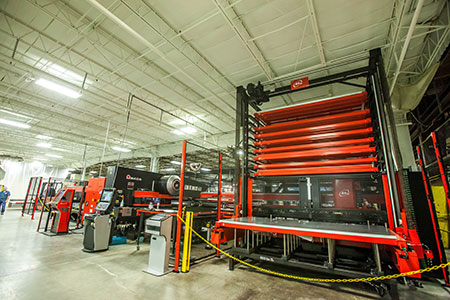Milbank’s Journey to Lean Manufacturing

An Amada installed in the Kansas City plant helps to automate work and make the production process more efficient.
One of the first companies to develop and embrace a lean manufacturing framework was Toyota. With the Toyota Production System (TPS), first formalized in the early 1990s, Toyota enacted its “Just-in-Time” approach to reduce waste by only producing what was needed when it was needed and empowering employees to ensure the production system ran safely.
Milbank’s lean journey started with using the TPS as a general guide to create its own lean process, the Milbank Production System (MPS). How did it all begin?
In the early 2000s, after facing issues with machinery and inventory, Milbank reached out to operational excellence experts, trained in lean principals, to offer guidance on adopting a lean practice. An internal committee was formed to partner with the outside experts in order to implement strategies for Milbank’s journey to lean manufacturing. One important factor was to ensure several Milbank employees became lean certified.
After reviewing current processes and bottlenecks, all parties involved agreed the first facet to focus on was 5S: sort, set in order, shine, standardize and sustain. With more than 400,000 square feet of manufacturing space spread across several states, this was no small task. The lean committee took the time to apply the 5S process to all manufacturing locations and the corporate office. After reorganizing all areas and assigning locations for all important tools and components, Milbank began to review specific manufacturing processes.
Lean-certified employees facilitated what are known as Kaizen events, where teams analyzed pain points in the production of specific products and the journey parts took through each plant. By including employees from different departments at Milbank in these events, the team was able to think outside the box and identify new ways to make the same product, faster and with less waste!
In one exercise, using a spaghetti diagram, the team discovered that parts and people traveled more than three miles from start to finish to assemble one of Milbank’s most popular meter sockets. By dissecting the build process, the committee identified several ways to reduce congestion and delays. After much debate and trial and error, the process for assembling the popular meter socket was streamlined to require only about 600 feet of travel.
Through the support of Milbank’s executive team, board of directors and third-generation family members, Milbank has concentrated on continuous improvement in all manufacturing locations. While the traditional lean process does not place an emphasis on technology, Milbank initiated a master plan in 2016 to invest in technology in several critical areas. These upgrades included adding Amada presses and other machinery to increase the production of components and decrease wasted materials. The addition of new software and diagrams on monitors at final assembly stations increased quality and decreased the time it took to train new employees.
The Milbank Production System continues to work toward keeping the ideal level of inventory to promote efficient production without taking up valuable space. This process means making adjustments as machinery changes over, component supplies vary and SKUs continue to be added and refined.
Milbank continues to innovate and incorporate new products and SKUs into all product lines including metering and enclosed controls. Production areas and corporate workspaces continue to follow 5S guidelines, never resting on a job well done. As product popularity changes due to updated NEC requirements and local utility preferences, the MPS reevaluates machinery, workflow and personnel resources to meet changing demands.
For a look at efficiency in action, see how the El Dorado plant operates below and learn how die runs and using Kanban has helped that location create product quickly on a lean framework: